Women reaches a higher population count than men
Based on the results of the 2020 Census of Population and Housing (CPH), the City of Mandaluyong had a total population of 425,758. Through the period of 2015 to 2020, the number of citizens in the city had increased by 10.2 percent or by 39,482 persons. (See Table 1)
The total population is composed of household and institutional population. Within the total population of Mandaluyong in 2020, 419,333 were household and 6,425 were institutional. (See Table 1)
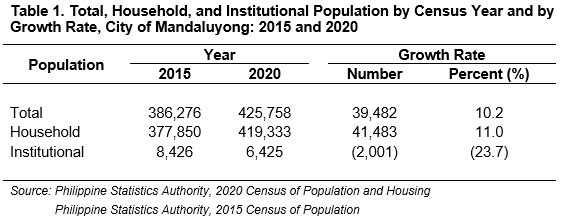
Meanwhile, in the number of household population, women (212,515) outnumbered men (206,818) by 1.4 percent or by 5,697 persons. With these figures, the sex ratio in 2020 resulted in 97 males for every 100 females. (See Table 4)
In comparison to 2015, women also outnumbered men but with a higher percentage rate than in 2020. Women exceeded the number of men by 1.6 percent or by 6,240 persons, resulting in a sex ratio of 97 males for every 100 females. (See Table 3)
Highway Hills holds the highest record for the growth rate of women while Buayang Bato holds the highest record for men
Among the 27 barangays of Mandaluyong, Addition Hills had the highest number of women and men wherein Mandaleñas were 52,160 and Mandaleños were 53,243. Addition Hills also prevailed as the barangay with the highest population back in 2015 with 96,282 persons – 47,257 were women and 49,025 were men. (See Figure 1 and Table 3 and 4)
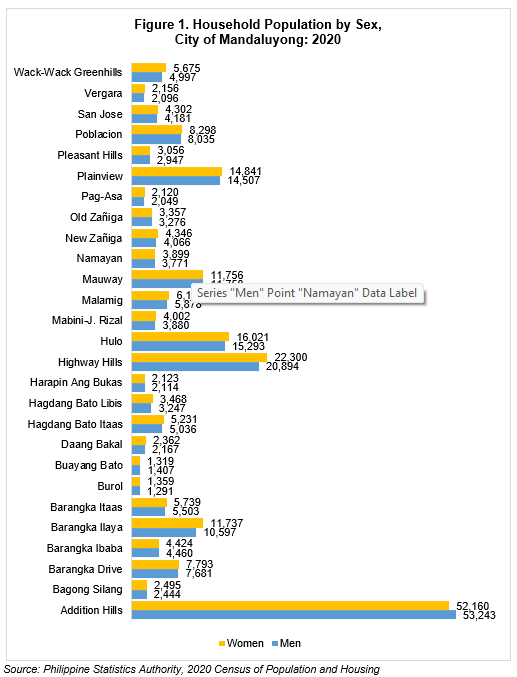
On the other hand, the barangay recorded with the lowest number of populations in 2015 was Barangay Buayang Bato and in 2020 was Barangay Burol. Barangay Buayang Bato had 903 women and 865 men in 2015 while Barangay Burol had 1,359 women and 1,291 men in 2020. Figure 1 also shows that despite women dominating the household population, there are still municipalities where men had a higher population than women. (See Figure 1 and Table 3 and 4)
Moreover, regardless of Addition Hills having the highest number of women and men, the barangay of Highway Hills recorded the highest growth rate of women with 51.0 percent while Barangay Buayang Bato recorded the highest growth rate of men in 2020 at 62.7 percent in 2020. (See Table 5)
The number of Mandaleñas being declared as household head is gradually increasing
There was a total of 116,954 household heads in the city as of 01 May 2020. Seven (7) out of 10 of these household heads were men (79,789) while three (3) out of 10 were women (37,165). The household head is a person who is 15 years old and over who generally provides the chief source of income for the household unit. It is an adult person, male or female, who is responsible for the organization and care of the household or who is regarded as such by the members of the household. In comparison to 2015, the household heads increased by 16.5 percent or 16,598 persons in 2020. (See Table 6)
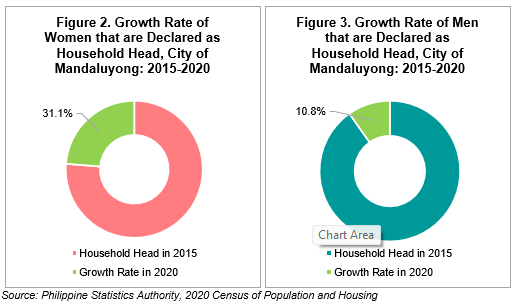
As time goes by, more males were consistently declared as the household head by their family or by their household members. However, we can also observe that the number of women who were declared as the household head were also gradually increasing. In fact, from 2015 to 2020, the number of women declared as the household head increased by 31.1 percent or by 8,814 persons. Meanwhile, household heads that were men increased by 10.8 percent or by 7,784 persons. (See Figure 2 and 3 and Table 6)
About 29.0 percent of the household population of Mandaluyong are married
In 2020, nearly half (48.0% or 201,323) of the household population of Mandaluyong were single wherein 97,867 were women and 103,456 were men. Moreover, about 29.0 percent (28.6% or 120,065) were married wherein 60,121 were women and 59,944 were men. Meanwhile, 8,897 were common-law or in a live-in set-up wherein 5,933 were women and 2,964 were men. On the other hand, roughly 3.0 percent (3.3% or 13,753) of the household population have been divorced, separated, or annulled wherein 11,168 were women and 2,585 were men. In addition, more than 75,000 (17.9% or 75,202) lost their wife or husband through death wherein 37,368 were women and 37,834 were men. However, there were 93 persons whose marital status was left unknown. (See Table 2)
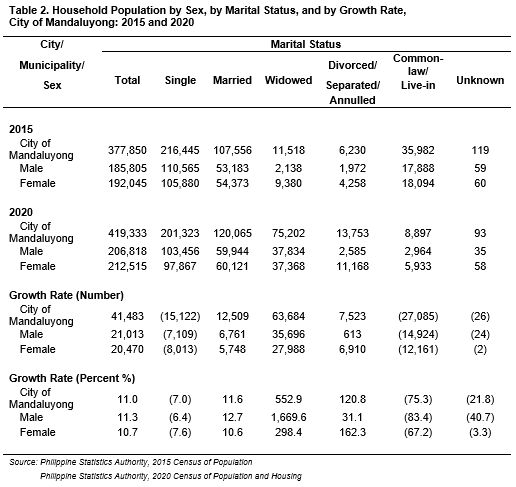
In contrast with 2015, the marital status of citizens in the city had a drastic change. The percentage of individuals who had a marital status of married, widowed, and divorced or separated raised by 11.6 percent (12,509), 552.9 percent (63,684), and 120.8 percent (7,523), respectively. On the contrary, the percentage of women and men who had a marital status of single, common-law or live-in, and unknown fell off by 7.0 percent, 75.3 percent, and 21.8 percent, respectively. (See Table 2)
The number of literate women in Mandaluyong is 2.0 percent higher than men
About 99.0 percent (98.8% or 376,120) of the residents in Mandaluyong ages 5 years old and over can read, write, and understand simple messages. Mandaleñas contributed approximately 51.0 percent (51.0% or 191,634) to this population, while Mandaleños contributed around 49.0 percent (49.0% or 184,486). (See Table 7)
The number of literate individuals in the city in 2020 were 11.9 percent (39,882) higher compared to the number of literate individuals in 2015. (See Table 7)
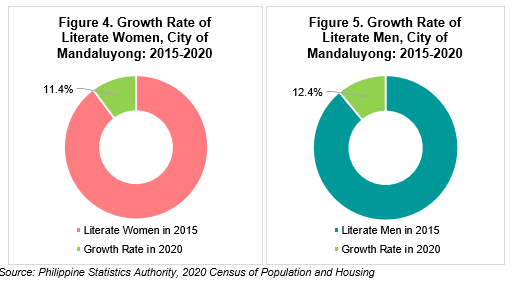
Figure 4 and 5 shows the growth rate of literate women and men in the City of Mandaluyong from the period of 2015 to 2020. The development rate of literate men were 1.0 percent (12.4% or 20,322) higher than women (11.4% or 19,560). (See Figure 4 and 5 and Table 7)
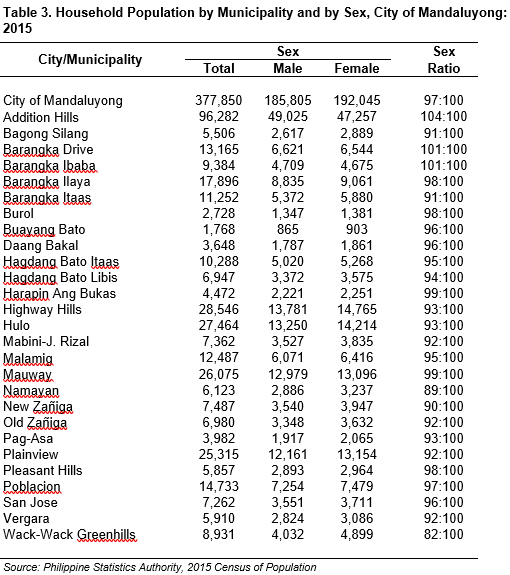
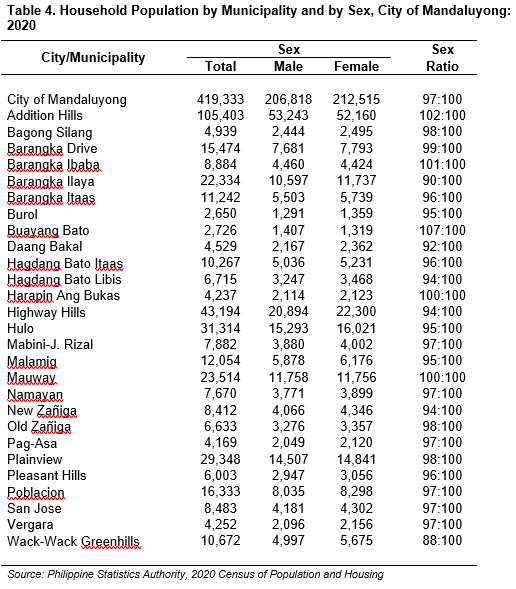
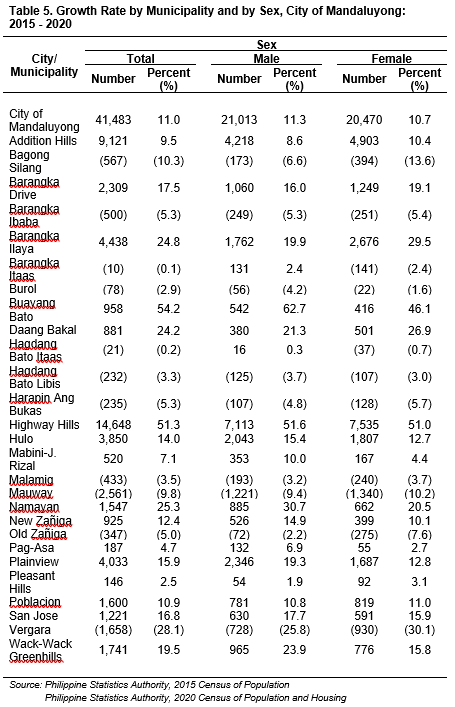
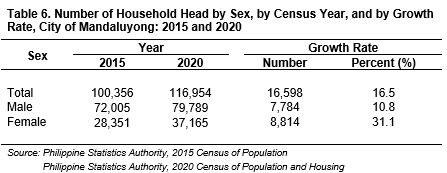
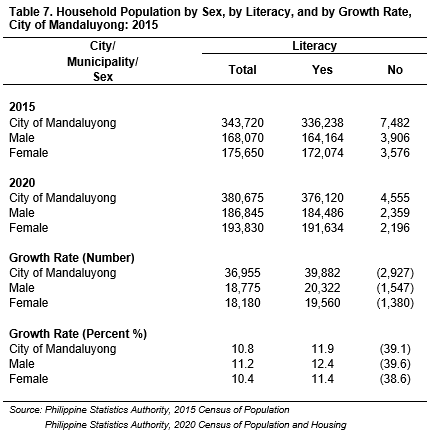
(SGD.) Amelia G. Basilio
Chief Statistical Specialist
Officer-in-Charge
